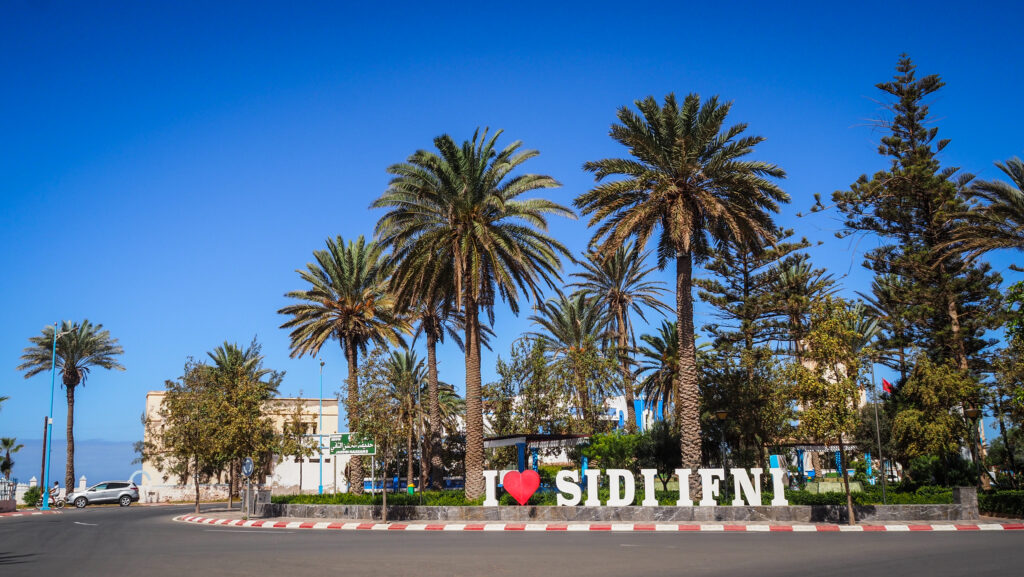The region between Mirleft and Sidi Ifni is characterized by a captivating coastal stretch along the southwestern part of Morocco. This area is known for its rugged cliffs, scenic beaches, and a blend of traditional Berber communities with a touch of colonial history.
While not as heavily developed as some more touristy areas, the region maintains a certain authenticity, offering travellers a chance to experience the raw beauty of the Moroccan coastline. Exploring the towns, interacting with locals, and enjoying the tranquillity of the beaches contribute to the charm of this coastal stretch between Mirleft and Sidi Ifni.
How to get there?
You can fly into Al Massira Airport (AGA) in Agadir and take a bus or grand taxi from there or from any other city in Morocco. It’s about 140 km and over a 2-hour drive from Agadir to Mirleft and from there another 20 km to Legzira Beach. Sidi Ifni is 10 km further to the south. Check your connections at 12go.com.
For those who prefer to be independent, I recommend using the service of Click’n’Go Car Rental in Agadir— very friendly guys and easy to contact on WhatsApp. I rented a Renault Clio for the whole month and got a nice price.
The best time to visit
The best time to visit the southern Atlantic coast in Morocco is during the spring (March to May) and fall (September to November) when the weather is mild and pleasant. Summer can be quite hot, while winter brings cooler but enjoyable temperatures. Choosing spring or fall ensures a comfortable climate for enjoying nearby beaches and exploring the city and its surroundings.
How long to stay there?
You should have a full day to comfortably enjoy the beaches in this region of the Atlantic Coast and have nice walks around Mirleft and Sidi Ifni.
Mirleft
During the 20th century, like many coastal areas in Morocco, Mirleft attracted attention from European powers. The town was used as a trade and fishing port by the Spanish, similar to the nearby Sidi Ifni. However, it did not undergo such an extensive colonization.
in the post-colonial era, Mirleft experienced development and growth, becoming a popular destination for surfers and travellers seeking a laid-back coastal atmosphere. The city doesn’t offer much but it’s the nearby beaches and scenic roads along the coast that justify the visit.
For the panoramic views, head to Fort de Tidli – the ruins of a French military fort. When it comes to the beaches, take your time to visit them all or at least stop by for some great photo opportunities or to admire the surfers: Imin Turga, Aftass, Sidi Mohammed Ben Abdellah, Tamhrouchte or Sidi El Wafi.





Legzira Beach
Legzira Beach is famous for its huge rock arch. The arch is accessible at low tide, and it is quite a stunning sight to see. It’s a short walk from the parking but optionally you can take a camel or quad ride. I don’t recommend it though as it’s much better to enjoy the place in silence, listening to the sound of Atlantic waves rather than a noisy engine.
There were originally two arches, but one collapsed in late 2016. Hopefully, the second arch won’t suffer the same fate as the ocean continues to erode the red sandstone from which it is formed. The beach is also a popular spot for surfing. It’s also worth checking out the other end, called Yasscobar Beach.
A bit further south there is a turn-off from the main road into the dirt one. Follow the directions to “Lkherba n’Brahim” on Google Maps. Take a path behind the building to the magnificent viewpoint on top of one of the cliffs.




Sidi Ifni
Sidi Ifni’s history is intertwined with both Moroccan and Spanish influences. Originally a modest fishing village, it gained prominence when it fell under Spanish control in 1860. The Spanish established a settlement, transforming the area with colonial architecture that remains a distinctive feature of the town.
Under Spanish rule, Sidi Ifni developed economically and culturally. However, tensions arose as Morocco sought to regain control of its territories. In 1969, after years of negotiations, Morocco reclaimed Sidi Ifni, marking the end of Spanish presence. The transition wasn’t without challenges, but the town gradually adapted to Moroccan governance.

The small old Spanish part of town is the main attraction. Hassan II Square is surrounded by colonial architecture, including the town hall, law courts, Hôtel La Belle Vue and the former Spanish consulate. Close to the square, you will find the lighthouse with some nice panoramic views of the beach and the Atlantic Ocean.


The beach is wide and picturesque although it’s not the best for swimming due to the strong waves and stones on the shore. Surfing is a popular activity here so you may test your skills or take a lesson or two.
Near to the beach, it’s worth checking out a bit of odd construction – the clifftop shiphouse, which served as the Spanish Naval Secretariat.




